Shapes and Decors... and All Those Glass Houses.
What should we really think about this??
by Craig Orkney
Where Do We Start?
Informed decisions are part of learning and developing the skills to collect and identify glass if you are passionate about your interest in it. The end result for some may be a combination of the many different opinions and methodologies. The opinions I present here regarding making attributions using decors and shapes are applied in conjunction with books (when available), photos, and personal experience handling glass. I think it is an important methodology whether it be Bohemian, Scandinavian, Italian, French, English, American, or any other glass which is being studied.
There are two sides to this idea of shape studies and deécor identifications as methods of attributing the production of glass to specific houses. There are those whothat believe that this is not a reliable methodology to apply. That ideology, in relation to Bohemian glass in particular, is based in the concept that most decors and shapes were made by many houses. There also seems to be the supposition that in many cases exporters determined shapes and decors, and filled high demands for quantity by ordering from several production houses. There is, at least to this date, very little supporting evidence for this last concept.
In the other camp are those who believe, that in the absence of much reliable or even available documentation, this is one of the only methods that makes much sense. This school also does not believe that the artistic output of the companies was so intermingled and convoluted that distinct decors cannot be used to provide a reasonably accurate idea of production sources for some previously unidentified glass.
So where do I stand on this subject? I stand firmly in opposition to the ideology that we cannot rely on shapes and decors. I do not believe the industry was so convoluted as to lead us down a path of misinformation if we pay attention to these details. This idea of downplaying shapes and decors, at least to me, would seem to fly in the face of so much of the artistic individuality we see among these companies. Many of these companies, whose history is known to us, had “Artistic” directors, individuals who helped to create a unique aesthetic image for their product line. Indeed, the lists of designers used by some of these companies is as equally impressive as their best products. I remember asking a collector once: "In the face of no documentation, if we disregard decors, and we disregard shapes, what exactly do we have left to examine?". My research of this glass, is for the most part, based in empirical research. Empirical research is, in my opinion, the most effective methodology available in the absence of much historical data or documents.
There also appears to be a move, by some, to classify the output of this region’s glass industry as "Bohemian Export Glass", “Bohemian Victorian Export”, "Deco Czech Export Glass", and other such terms. These terms imply the resignation of oneself to the position that the product can not be identified due to the convoluted production by many houses.
After only 20 or so years of unbridled access to the region, I am not even mildly convinced that we have learned all we can learn about these companies. Do I feel we will ever figure it all out? Absolutely not. But I do believe there is much more to learn than is accomplished by classifying much of it as "export glass" of one kind or another. Some have classified the desire to identify glass as an "ID Mania" by collectors and dealers. I simply define it as an unending quest for knowledge, an understanding of an industry and it's production about which we have less information than we would like.
So I guess it really comes down to me asking myself: “Do I really believe that this industry which left behind such colorful, artistically unique, and design-forward product, was relegated to simplistic shape designs and producing common decors to the point that decors and shapes are not reliable means of attribution?”? Quick and simple answer for me.... No hesitation and no stutter.... Absolutely not. And on the flip side of that..... “Do I believe that any house could produce any decor developed and designed by another company?". This would be another resounding NO! Personally I am of the belief that within any given house there were levels of execution at which different gaffers could produce product. So, do I believe that every piece in a given decor from the same house is going to be identical? Another resounding NO.
So what do I think makes sense? I personally believe that there are decors and shapes that can allow us to reasonably determine who made some of this glass about which there are really no solid, complete, or known records. Do I think all shapes? Of course not. Most people don’t. Do I think all decors? Of course not. Some are simply too generic and on shapes much too common to be attributed, and likely never will be. Do I believe that any house that produced art glass is immune to these differences in shape and quality of production within even their own line? Absolutely not.
I believe we can develop attributions of this glass utilizing decors and shapes showing some unique production techniques and artistically unique characteristics, at least as a starting point. I also believe we need to be careful when doing so, and extremely attentive to small details which may help us differentiate shapes and decors. If we are really lucky we can find a labelled piece or two to aid in developing the picture we are trying to assemble from the random puzzle we are attempting to reconstruct.
Let's first take a look at Shapes
My experience, through many years of doing this, has taught me that shapes, as with everything made by hand, will commonly show some differences. Even when we are talking simple or complex shapes from the same house. Will some be the same, within reasonable expectations? Yes..... But I repeat..... This is hand produced product blown in hand made molds, and in many cases manipulated additionally after being removed from the mold.
There are certain areas of glass collecting and study where exact sizes are critical to identification. Among these are items such as patterned Carnival glass. This style of glass is produced by pressing gathers in metal molds. In this case there will generally be a consistency we do not see in hand blown glass. Here, exact dimensions can come into play to determine the manufacturer of a piece.
I also believe that there are certainly shapes from different houses which are quite similar, yet a close examination will generally reveal some differentiating details. As part of this discussion we will look at just such an example.
But first, let’s look at some shape examples which are the “same”.
One of the arguments that has been presented when discussing the use of shapes, is that the same shape from the same house will always be the same. So if the shapes are different, then they are likely not the same house, but the same shape and decor by two or more houses. My experience has taught me this is generally not the case. My experience is that the same basic shape from the same house can vary pretty substantially in some cases, and with minor, but noticeable differences in other cases. We do also see some examples that appear to be identical.
The first two picture groups below show examples of pairs of vases done in artistically unique decors. The decor on the first pair in particular is most likely unique to the house that produced it. In this case I believe the production house was Franz Welz Klostergrab. I do not own these pieces so I cannot provide exact measurements, but I believe the stated differences can be easily seen without dimensions.
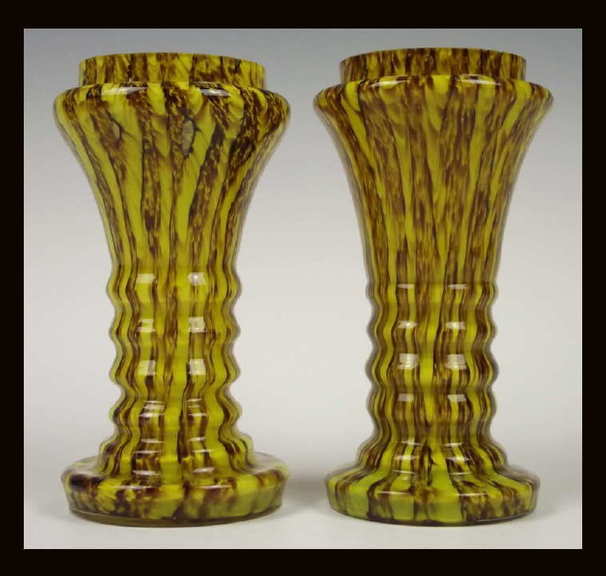
- The bases are different widths.
- The bases are different heights.
- The shape of the first “step” above the base is more vertical and squared on the left vase than the right.
- The shape and thickness of the five ribs are different, and in some cases appear to be at slightly different heights.
- The upper shoulders of the two vases are obviously quite different shapes.
- There appears to be a slight height difference between the two.
How can there be so many, and such obvious differences, especially in light of the fact that these were blown into molds that determine the shape? Let’s look at some more examples before I discuss my thoughts on the subject.
The next two pairs are examples I believe were also produced by Welz. I do not own these pieces either so I cannot provide exact measurements, but again I believe the stated differences are visible without dimensions.
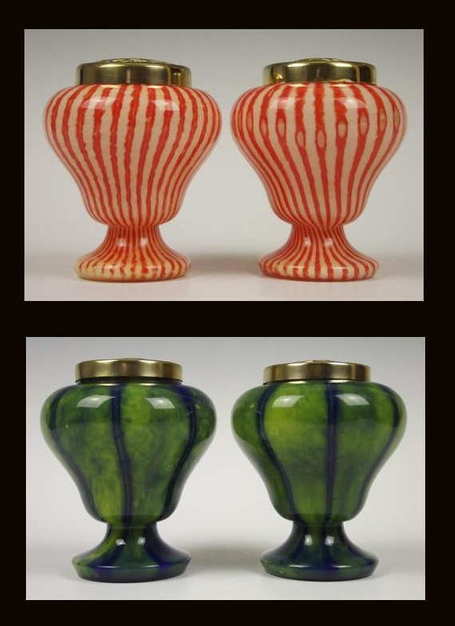
- Top Pair - The shape of the base is slightly different.
- Top Pair - The area where the vases transition from the stem to the body of the vessel is slightly different.
- Top Pair - The top of the shoulder area of the example on the left is flatter than the right example.
- Bottom Pair - This pair appear to be basically the same, with a possible small difference in the height of the bases.
Not as many differences, and certainly not as pronounced as the first example, but again..... small differences between two pieces of glass I am confident stating are from the same house and same basic mold.
This next image is of a pair of vases produced by Kralik in the Abstract Flower decor.
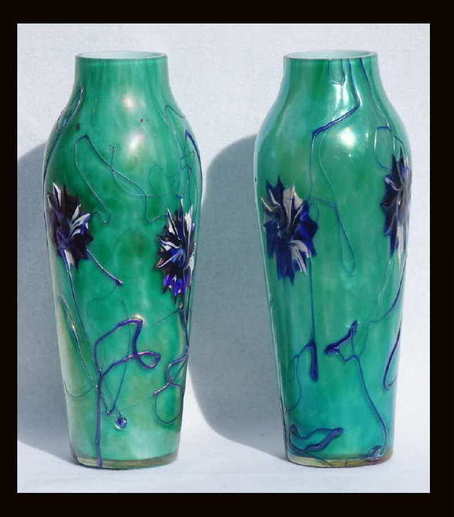
- The neck of the left vase is longer and also a little thinner than the right hand example.
One noticeable difference and certainly not pronounced..... but again we see small differences between 2 pieces of glass I am confident stating are from the same house and mold type.
As another example of the same shape and same decor let’s look at a pair of Loetz Rosa Argentan vases. Certainly if anyone could produce the same shape all the time from a mold, it would be Loetz!!
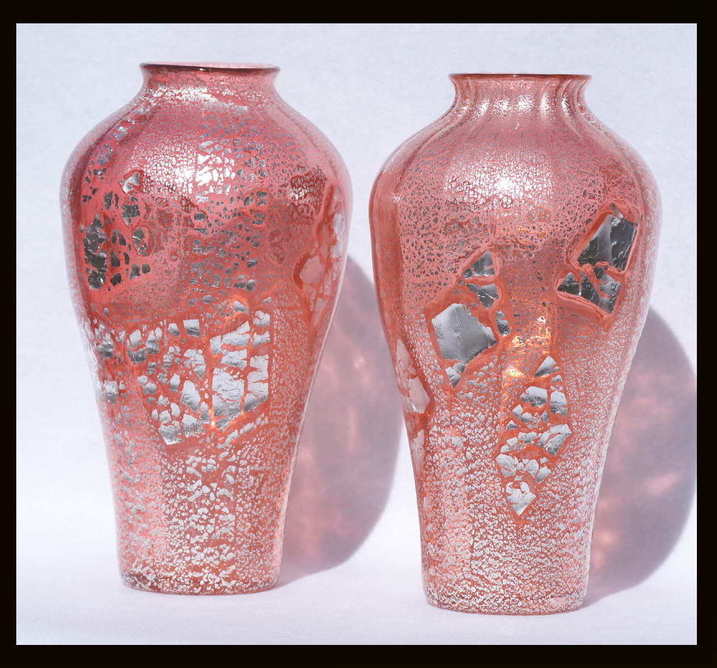
- One vase measures 8.875 inches tall, the other is 9.125 inches.
- The neck on one is .5 inches long, the other is .75 inches.
- The neck and shoulder area of the longer necked vase has substantially more pronounced ribbing.
- The shoulder angle of the shorter neck vase is steeper.
- The maximum width of one vase is 4.875 inches, the other is 5.125 inches.
- It is worth noting that the mouth and base diameters are the same on both examples.
The Loetz pair were likely purchased together originally, and were given as a gift together some 60 years ago. Based on the scarcity of the décor, and the scarcity of examples this large, I think it is a reasonably safe assumption that they were produced at the same time, and likely by the same gaffer. Yet, these two pieces show some reasonably distinct differences. I even suppose that if they had different decors on them, one could argue they were a similar, yet different shape from different houses. In this case, the shape is one I would classify as fairly generic. Not distinct in any way other than decor, and the optic ribbing which both vases have to some degree.
This next pair comparison will be of the same shape, in two different decors. These are two pieces I attribute to Welz.
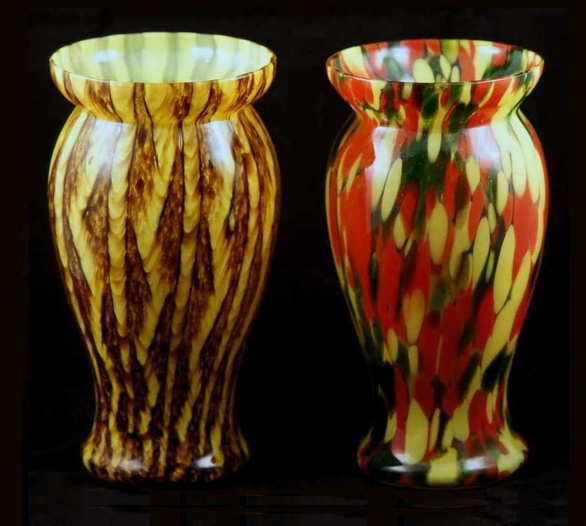
- The left example is just under .25 inches taller.
- The shape of the top of the lip leading up to the rim is slightly different between the two.
- The diameter of the mouth is slightly larger on the left example.
- The diameter of the foot on the right piece is .25 inches larger.
- The shape of the lower portion of the foot of the two vases is slightly different, with the right example being rounder and the left example being more angular.
In this case we have the same basic shape exhibiting some physical differences with two completely different decors. Am I confident they are the same mold from the same company? Yes.
The current value range of these examples varies from a little over $100 per pair to many thousands of dollars per pair. The price range of these above examples were also likely quite different when they were produced. I point this out in order to demonstrate that these differences in shape are not related to house, complexity of shape, complexity of the decor, or price range of the product when produced. They are simply the production artifacts of hand made glass blown in hand made molds, and are the nature of the beast, regardless of who produced them, or at what cost they were produced.
Let’s now examine a very distinct shape, and some variations of it, likely produced by multiple houses. These would be the examples in the image sets below labeled with Welz, Possibly Harrach, and Unknown.
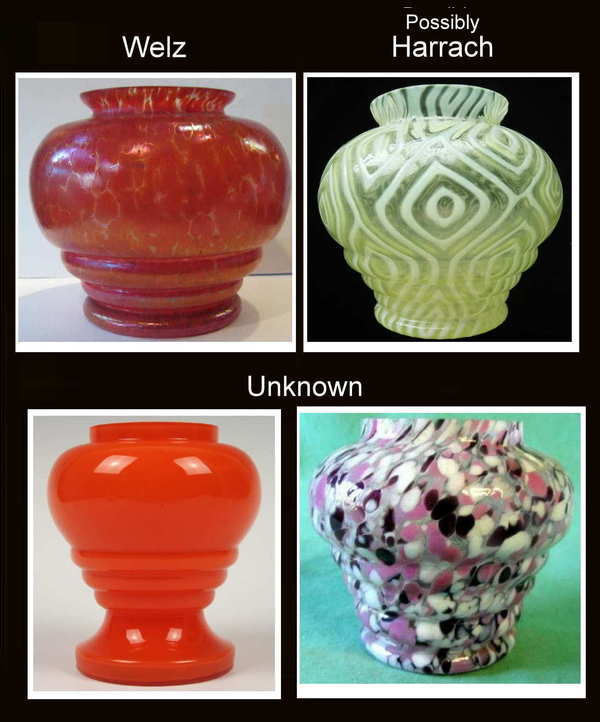
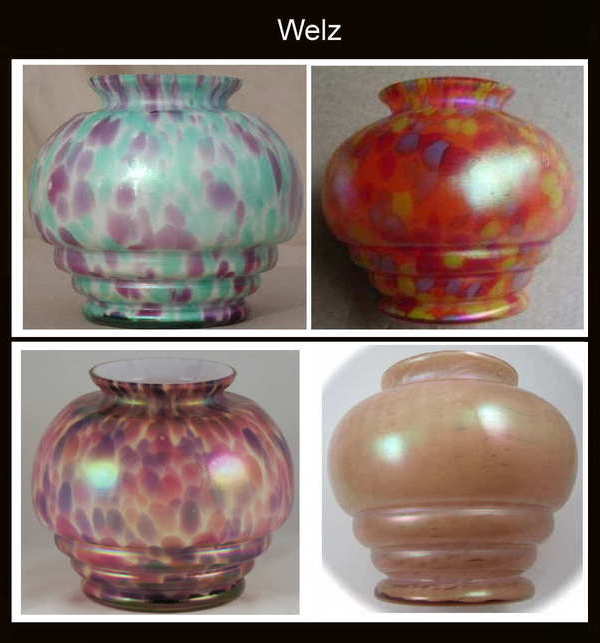
The opalescent example in the upper image is a decor possibly produced by Harrach. A quick glance at this shape and the example to the left of it would leave one with the quick impression that these are the same shape. In fact, a close examination of the opalescent version of this shape reveals that there is one more “rib” in the lower portion of the vase than in the examples I have identified as Welz. The lower red example has a similar shape, but with a stem between the foot and the body of the vase where the ribs start. The spatter vase under "Unknown" is also quite similar to the opalescent shape, having the same number of ribs, but the mouth is quite different and the shape is similar, but not the same.
So what this shows us is another example of things we need to observe..... An identical shape? No. A quite similar shape, yet one that is fairly unique? Yes… So the determination is in the details, the subtle differences in quite similar shapes by different houses. We also need to take into consideration the subtle, and at times not so subtle differences in a common shape by the same house. Additionally, similar shapes from the same house must be considered. So let's take a look at these possibilities for a moment.
This first example below will be a pair of vases I believe to be Welz production. Obviously the same decor, and basically the same shape. The overt differences in these pieces would more than likely be the result of different molds and slightly different manipulation in the final stages of production. The differences are quite apparent, while the obvious similarities are there also. The most striking differences are the variations in the neck and foot regions of the shapes.
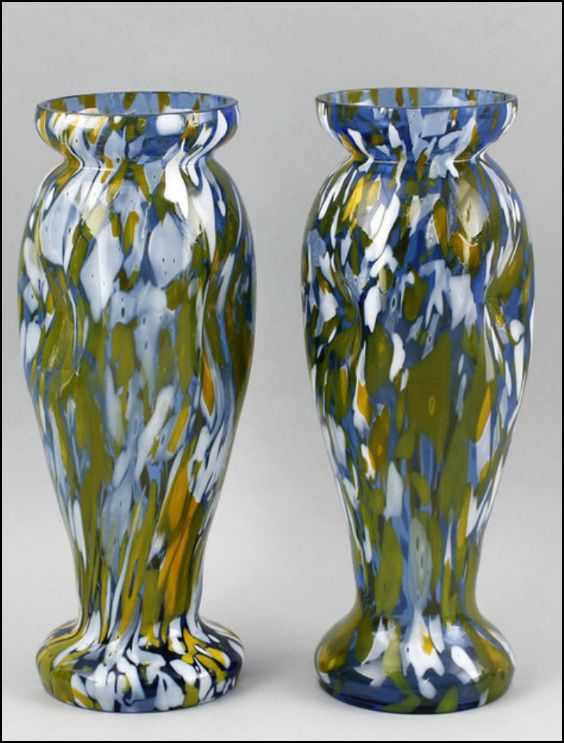
This next example compares two things. First, although a quick glance would seem to reveal that there are three examples of the same shape in the same decor, there are actually two distinct shapes here. The first example is one distinct form, and the second and third are a different form than the first. In comparing the second and third examples we find what I believe are examples of the same shape, the middle example having been produced with a relatively new wood mold, and the third example showing less detail, as the mold that was used appears to be near the end of it's life-cycle. The third example show substantially less detail in the stem/foot region of the shape.
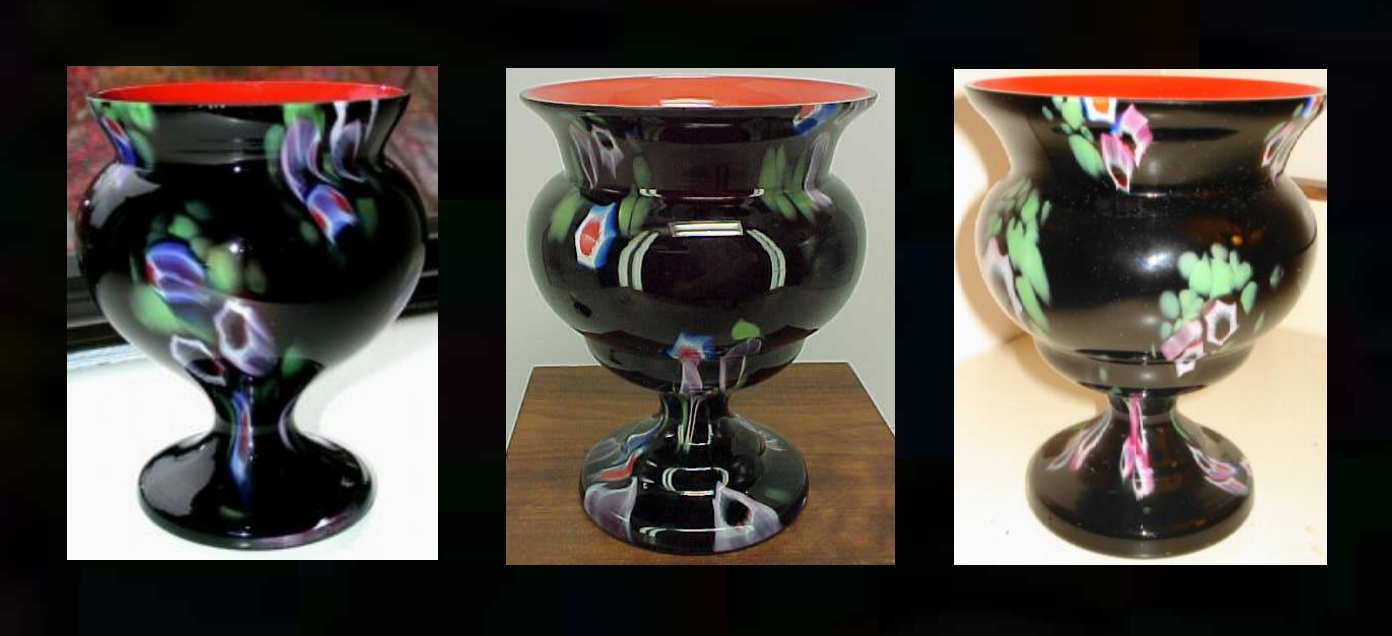
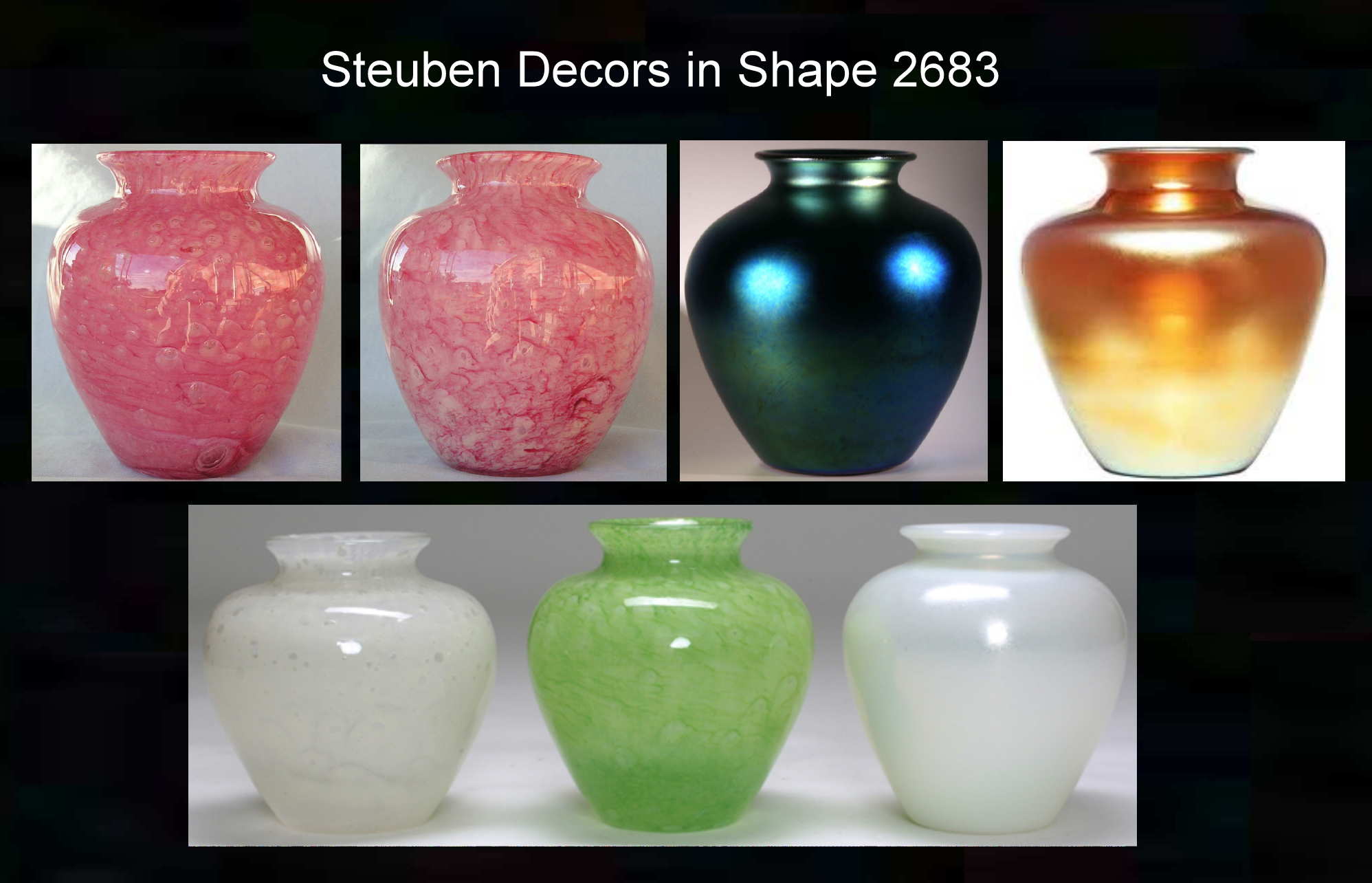
- Some are too mundane and ordinary to ever be used for ID purposes.
- Some are unique, yet similar to other houses shapes, so caution must be exercised when using those forms.
- And finally my belief, that some are unique, and will be unique to the house that produced them. In these cases I believe the strength of the attribution link is rock solid.
These wonderful devices are absolutely necessary to create a defined shape from a gather of glass. And to do it over and over again. Let’s first talk about what they are commonly made of..... Wood. How can that be? Molten glass is very hot, certainly hot enough to burn wood. The soaking of wood molds in water prior to the introduction of molten glass helps to reduce the interaction between the wood surface and the glass surface by creating a cushion, or layer of steam between the glass and the internal surface of the mold. The expansion of the steam as it is created helps to force the surface of the gather off of the wood mold itself. Think of it like an air hockey table lifting the puck off the table surface. Modern wood mold manufacturers will tell you that a mold is good for 100 – 500 pieces of glass, depending on the tolerances of shape that are required of the product. In the case of art glass I would assume that exact tolerances were not critical, so the molds were likely used as long as possible before they were replaced. Is the shape of the mold and the glass it produced different from production unit #1, and lets say #500? Absolutely.
The left side of the image below shows some new and used wood molds, and also some metal ones.
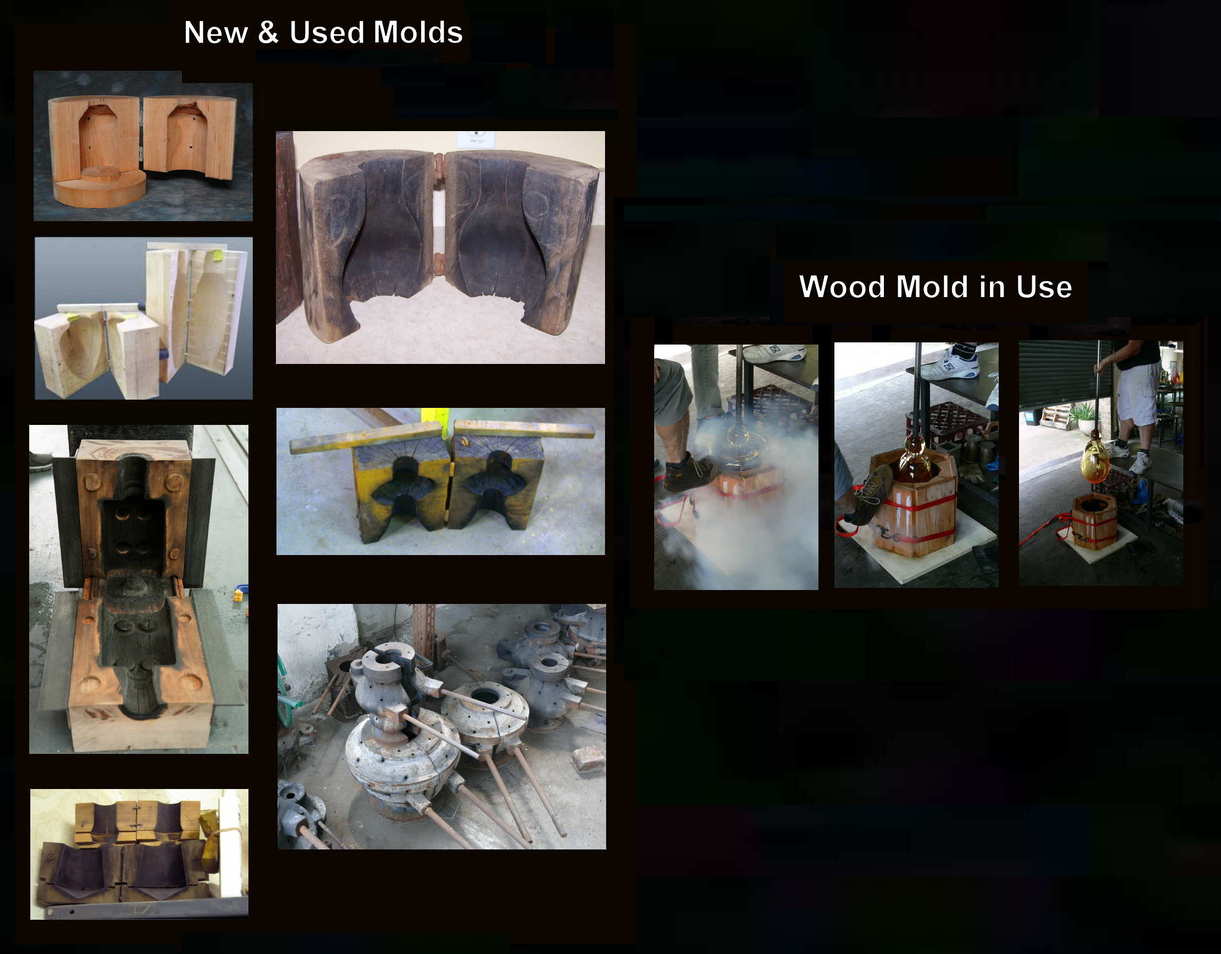
How were these wood molds made? By hand in a mold shop at the glass house. So it would seem to me to be a reasonable assumption that each copy of a mold that was made, likely had some differences between them. Especially those shapes that were more complex. I think the very first pair of vases above shows that two molds of the same complex shape were likely not exactly the same. Even if we have a method to ensure that each and every copy of a mold is identical to begin with, let’s examine what happens when they are used. Even though they are soaked in water the images above clearly indicate that they burn, expand and contract through the application of water and heat, and simply change shape with use.
So the question that presents itself to me is: ”Do I think that the form a mold blows when it is new, vs. the form it creates right before it is replaced is going to be the same? In most cases I would venture that they are basically the same, but on closer examination, can still be quite different.
Let’s discuss briefly how I believe glass orders were placed and who I believe actually controlled production. We know from Loetz records that in some cases orders were placed directly by retailers. We also know from early catalogs and other documents that orders were also placed by wholesalers who likely acted as importers, and possibly worked in conjunction with exporters local to the production houses to provide a viable stream of goods for their catalog orders. It appears that in later time periods some of the production houses may have acted as exporters for their own goods.
Butler Brothers in the U.S. is a very good, and fairly well documented example of this wholesale ordering practice. When it came to art glass, Butler offered “assortments” which varied by style, price range, and assortment size among other things. In the case of Butler Brothers it is known, that although they rarely divulged the sources, some of the glass products were shipped in barrels which were factory packed, and as a result of that knowledge, if you can identify one piece, you can identify the manufacturer of the assortment. This information is discussed in the foreward to Monograph 121 from the West Virginia Museum of Glass. This Monograph was produced as a result of a request I made to the Museum relating to some work I am doing on the identification of “assortments” of art glass imported by Butler.
I will save an explanation of my work on Butler for some different articles on this site, but let it suffice to say, that I believe the packing of items in barrels indicates that at least in some cases the glass houses controlled production and shipping preparations of product. This belief also halso address in a different article.
In regard to "split production" ideas, I have also heard it suggested that the exporters supplied molds to the houses that they ordered glass from. I personally do not believe that this was the practice. I do not believe exporters had molds at all.
Here is what I believe to be logical, without any documentation to show me otherwise. Exporters were in the business of exporting glass. They were not in the business of making molds and supplying them to glass houses to meet production orders. Companies such as Kralik, Loetz, Welz and others likely produced thousands, if not tens of thousands of shapes. I do not see them allowing control of those molds to fall anywhere but in house. I also do not see exporters creating molds for glass houses to use. So glass houses building and controlling their own molds is, at least to me at this point, the only logical assumption.
Now let’s briefly examine the presumption that the same shape is ordered by an “Exporter” from 2 or 3 different houses. Three shops build a mold to the same ”specs”, and then all 3 shops create a vase using the mold they created. Let us momentarily remind ourselves that this is art glass, and not machine parts requiring a specific and exact tolerance from piece to piece.
My own personal belief is that in most cases exporters and importers did not design glass, they simply ordered it from the houses that produced it. Retailers were known to request specific designs, or supply designs to be produced, but these appear to be more of the exception than the rule.
So what exactly does that mean with regard to shapes? To me it means that the control of shapes was likely in the hands of the houses that produced them, and was based on the price range of the ordered assortments they were filling.
The question I now have to ask myself is: “Do I think three different glass houses would build wood molds by hand exactly the same, and then proceed to blow vases exactly the same from identical molds?” Once again, my answer to that, and I think it is a reasonable one, is NO. The first pair of vases above demonstrates that the same house could not duplicate identical shapes all the time. So how could I reasonably believe that multiple houses could duplicate each other in such a manner as to result in the dismissal of shapes as a valid comparative technique? Frankly, it should be obvious by now that I don’t.
True, specialty retailers such as those in the Loetz client lists are known to have had glass produced and designed specifically for them. In most cases though, we are talking about mass production and exported interwar glass, and not high end designer items. I personally do not believe that exporters controlled shapes at all, other than requiring artistically pleasing assortments.
Let’s look at the decor on the very first shape above. Do I think that just any house could produce it? No. I think that some decors are such that they could be produced in reasonable facsimiles of each other by different houses. Not identical to each other, but reasonable enough to ship as the same product in an assortment of art glass. Do I believe this to be true of all decors? Absolutely not.
I believe that in some cases orders may have been split between houses, but not all of the time, and not to the degree that cancels the use of unique decors as a reasonably reliable tool for determining the house of production. I also am of the belief that if multiple houses were involved, the subcontracting was likely controlled by a primary house, and not by the exporter.
There are shapes and decors out there we will likely never attribute to anyone. Maybe because they are too generic, maybe because there are too many and they are all similar but different, maybe because we do not even know the house that made it existed. All of these reasons may be absolutely undeniable, but does the use of shapes and decors that are not so commonplace make sense? Absolutely it does. Without them, we really have nothing!
We refer to books, and trust in the information that is in them.... not all books, and not all the information they contain. Some we know include unfortunate mistakes. Others we know to be wrong based on advancing research and new discoveries. We look to a book and identify a vase based on a picture in the book, and yet when we look to the glass and decors some say we can’t as it is not reliable. I truly do not understand the difference.
I ask myself: "What do we do, when the book does not exist, when the work has never really been done, and the records are not known to exist?" I cannot answer for everyone, but I can answer for myself. You exercise prudence and judgment while maintaining a necessary and mandatory level of patience, so you can proceed with caution to what you hope are the right answers to the constantly evolving questions. Will there be mistakes made? Without a doubt. But do we discount and ignore all that is before us to observe and evaluate because of the fear of making a mistake? Again my answer is No.
My own particular research has in part, been confirmed by recent exhibitions of Czech glass. Has it all been confirmed? No. But what it does show is that early attributions I made using this process have held up, and I am reasonably confident that the vast majority will hold up to the test of time and additional research. It is a methodology that I believe can be learned and reasonably applied by anyone looking to study glass.... any kind of glass.
This is not an exact science, and never will be. In many ways, it is far from exact. I believe if one uses careful observations, reason, logic, patience, and in some cases just a little common sense combined with occasional dumb luck….. I think we can get to something that closely resembles actual facts.
.
.